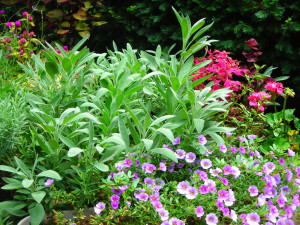Nothing beats the taste of a just-picked tomato or the bright flavor of fresh herbs. If you’re looking for great flavor this year, it’s time to start planning and planting your vegetable garden.
Many vegetables, fruits and herbs are easy to grow if you follow a few simple steps:
Find a sunny spot outside.
Most vegetables, fruits and herbs need several hours of sunshine each day to grow well.

Decide where to plant.
You don’t need acres of land for a vegetable garden. Tomatoes, peppers, lettuce, spinach and most herbs can grow well in containers. Herbs like basil, cilantro, parsley and oregano can grow in smaller pots (at least 8” – 12”) while larger plants like tomatoes need more room to grow. Look for containers that are at least 16” wide.
Get the soil ready.
If you’re planting outside, wait until the danger of frost has passed if you’re planting summer crops like peppers, zucchini or tomatoes. With a pitchfork or shovel, loosen the top few inches of soil. Add compost to the soil. For container planting, use fresh potting soil and add a bit of compost.
Pick your plants.
This is the fun part. There are endless varieties of vegetables and herbs to choose from. Here are some guidelines for deciding what to grow:
- How much space do you have? Some plants like pumpkin or melons have trailing vines that need plenty of space. Tomatoes, peppers and beans grow upright, so they can fit in a more compact space. Herbs generally can grow in a tight space too.
- How much water is available? If your community has restrictions on water use, look for plants that are drought tolerant. Some herbs like rosemary and lavender thrive with very little water.
- What do you like to eat? Plant your favorites. I love cherry tomatoes, so I plant them every year. In the late summer, I often pick the sweet tomatoes for a snack while I’m gardening. Yum!
Seedlings from your local garden center are a great way to get started. But remember that these small plants will grow, so leave plenty of space between plants. Overcrowding in the vegetable garden can lead to problems with plants.
For more ideas on planting your food garden, check out these sites:
- Fruits and Veggies: More Matters
- Burpee Seeds: Gardening How-to Videos
- Better Homes & Gardens: How to Plan a Vegetable Garden
A little work in April will give you a great harvest by late summer. Happy gardening!

